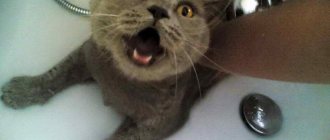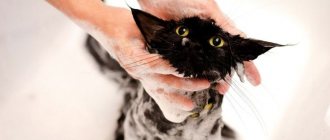Anyone has noticed that cats are incredibly brave and freedom-loving animals, which, when the vacuum cleaner is turned on, will run away from the room.
Naturally, the question arises: why are cats afraid of the vacuum cleaner? In fact, cats are afraid not only of the vacuum cleaner, but also of any unfamiliar object, especially one that makes such noise. Even if our smaller brothers remain in the room, they still experience a feeling of fear, and this is very dangerous for their health. Let's try to figure out why a cat and a vacuum cleaner are completely incompatible things, and how they can exist in the same space. Moreover, this technique is a necessity in a home where there is a cat, especially if it is long-haired.
A cat and a vacuum cleaner are the main “grievances” of an animal
Cats are afraid of vacuum cleaners for several reasons. And today, we will look at each of them.
- As mentioned earlier, pets do not like noise, so they are afraid of vacuum cleaners. You can understand the cat, because the vacuum cleaner is twice its size. Just imagine if there was something working next to you that was twice your size. You would probably be scared too.
- Another reason why pets are afraid of the vacuum cleaner is the behavior of cat owners. Yes, yes, exactly in them. Very often, for fun, the owner of a cat deliberately scares the pet with a vacuum cleaner, drawing the pet's fur into this device. Yes, such a sight looks very funny, but think about your cat. At this moment, the poor thing is experiencing extreme stress. Therefore, for the safety of your pet, never try to “vacuum” your pet.
- Most cats see the vacuum cleaner as “an unknown monster. That is why they run away from him, hiding under the sofa, and watch the “monster” from afar. By the way, the bravest cats even fight with the vacuum cleaner.
Cats are cute, defenseless animals that need to be protected and protected from everything. That is why you should never scare a cat with a vacuum cleaner. It is best to accustom your pet to noise.
Owner's carelessness
Cats often start to panic when the vacuum cleaner is turned on. And all this is because the introduction of the animal and the device occurs suddenly, when the pet is absolutely not ready for it. For example, a cat is absolutely defenseless when it sleeps. There is a category of people who turn on the vacuum cleaner only at times when it is convenient for them. The vacuum cleaner appears to the cat as if out of the ground and naturally makes a terrible impression on the animal. Once and for all, the cat begins to be afraid of technology. There are irrepressible owners who also have fun when they see the animal’s panic reaction.
How can you tell if your cat is afraid of the vacuum cleaner?
This can be determined by the main signs of fear:
- dilation of the pupils of the eyes;
- tousled fur;
- attempts to hide in a secluded place;
- the desire to escape from the room where the device is turned on;
- if you want to calm the animal and pick it up, it may bite and scratch;
- the pet may hiss and meow loudly;
- the desire to run out of an apartment or house through an open door or an open window.
Gallery
In the photo, the cat climbed onto the vacuum cleaner.
The first acquaintance of puppies and a robot vacuum cleaner.
Finally, we present you with some videos. Here you can see an example of the friendly relationship between an animal and a vacuum cleaner.
And this video shows the first meeting between a cat and a robot vacuum cleaner
As you can see, there are many disadvantages of buying a robot vacuum cleaner for a home where a pet lives. But it still has its advantages. The vacuum cleaner removes dirt and hair much better. Therefore, the choice is yours.
Help me choose a vacuum cleaner for a home with pets
The range of Xiaomi robot vacuum cleaners is generous and is regularly updated. So that you can choose a device that suits your requirements, we have made a detailed guide.
What parameters are important?
— Battery capacity, operating and charging time. For a small apartment, these parameters are not so important, but for large rooms you need a robot vacuum cleaner that can clean non-stop for a long time and not linger on charging;
- Suction power. The higher this number, the more success you will have when cleaning coatings. Long-pile carpets definitely need good power, which will help pull out dust, wool and debris that are deeply embedded;
— Dimensions. In order for the vacuum cleaner to remove dust under your bed, cabinet or closet, its size should not prevent free movement in such hidden corners;
— Dust container volume. Why are robot vacuum cleaners attractive? Because they free us from dirty work! If the apartment area is large or there are furry pets in the house that produce a lot of fur, then it is better to choose models with a larger capacity: they fill up more slowly;
— Programming. If you have this function, you will be able to plan the work of the robot vacuum cleaner in advance;
— Navigation type. The steeper the navigation type, the better the vacuum cleaner will navigate in space and leave fewer dirty areas. The simplest types of navigation are a mechanical bumper + IR sensors/gyroscope, more reliable and effective are laser rangefinders and cameras;
— Cartography. The function of building a map of the room will allow you to achieve ideal cleaning quality, since the vacuum cleaner will move along the correct trajectory and clean the entire floor surface without “bald spots”;
— Motion limiter. An additional accessory that creates a virtual wall, limiting the vacuum cleaner's access to fragile items or leaving the room.
Need an inexpensive assistant Xiaowa Robot Vacuum Cleaner Lite (C1, C102)
The main budget smartphone of Xiaomi, suitable for any wallet. There is no laser sensor, so navigation is the simplest - adaptive and arbitrary. The distance to obstacles is measured by a special built-in module. Height sensors prevent falls, and a mechanical bumper softens impacts from accidental collisions. The device has the largest trash tank and needs cleaning less often than others. One battery charge is enough to clean a standard two- or three-room apartment. Dust and small debris are collected by the main and side brushes; local cleaning is possible.
Mi Robot Vacuum
A little more expensive than the previous model, but with a laser rangefinder (read improved navigation), greater suction power and 2.5 times increased autonomy. It grips carpets and thresholds a little worse, but at the same time it moves less chaotically and provides better dry cleaning.
Xiaowa Roborock Robot Vacuum Cleaner E35 (E3, E352)
The most powerful, productive and precise robot vacuum cleaner from the Xiaowa series. Sweeps and wipes floors, effectively sucks up debris due to high pressure and the streamlined shape of the air passage. Equipped with 13 sensors, it can automatically plan a route and cleans in straight lines without deviations.
I don't want the vacuum cleaner to be stuck charging forever.
Viomi Cleaning Robot
Energy-efficient vacuum cleaner for medium-sized rooms. On one charge it will be able to restore order in two ordinary three-room apartments. He won't leave the cleaning halfway. And to fully recharge, it takes half as long as most other robotic vacuum cleaners. Thanks to its high suction power and stable behavior on uneven surfaces, the model cleans thick carpets well. The water tank is enough for 30 wet cleanings. The vacuum cleaner operates in three modes: normal, eco, turbo.
Need a vacuum cleaner for cleaning a house with children and pets
Mi Roborock S6 (T6)
A super-powerful, quiet, easy-to-clean robot vacuum cleaner will keep your home in constant order if someone is always littering. The high suction power leaves no chance for dust or spilled salt. The noise suppression system makes cleaning 50% quieter than other vacuum cleaner models, so children won’t wake up or animals won’t be scared. Hair wrapped around the brush is removed in 2 seconds, and disposable rags for wet cleaning will free you from fussing with sticky hair and dirt. I washed it, threw it away, and installed a new one. The function of highlighting a restricted area eliminates those situations when the vacuum cleaner accidentally catches your pet’s bowls and destroys fragile things in the house, for example, a construction set assembled by a child.
I want an advanced vacuum cleaner for perfect cleaning
Mi Robot Vacuum Cleaner 1S
This robot vacuum cleaner has one of the best navigation systems, which combines the power of a laser rangefinder and a built-in camera and increases cleaning efficiency by 13%. And the new 4-core processor reduced energy consumption by 10% and improved performance by 40%. Being perfectly oriented in space, the device does not leave “islands” of dirt after cleaning, which sometimes happens in the case of budget vacuum cleaners. The floor becomes a solid ten percent clean.
I need a functional average
Mi Roborock Sweep One
It will collect debris and dust from surfaces with a turbo brush and carry out wet cleaning using a microfiber nozzle. Metered automatic water supply will wet the cloth with the right amount of moisture so that there are no wet marks left on the floors. Lidar scans rooms 360 degrees, and sensors accurately measure the distance to obstacles. The E-11 HEPA filter captures 95% of dust for cleaner air in your home. Quiet, standard, power and maximum operating modes allow you to clean with different power, depending on the type of coating. The robot can be programmed in advance for the desired operating hours.
Mijia Smart Robot LDS Edition
Simultaneously sweeps and mops floors, or can carry out dry and wet cleaning separately. Simulates manual technique and cleans everything in two steps for a sparkling clean. Creates a map of the room and divides it into zones for more effective cleaning. You can set the route of the robot vacuum cleaner yourself by defining areas where you cannot go. It works quietly and for a long time, one charge is enough for several cleanings in an apartment or house.
Need a vacuum cleaner for a small apartment
Xiaowa Roborock Robot Vacuum Cleaner E20 (E2, E202)
An inexpensive, simplified robot vacuum cleaner that has not received fancy mapping skills, but does an excellent job of cleaning small-sized apartments and houses. Thanks to its high power and automatic increase in suction force, the device efficiently cleans any type of surface, including “difficult” carpets. The brushes direct debris toward the suction port, and the microfiber cloth provides a refreshing, damp mop of the floor. A spacious container for garbage will allow you to care for the vacuum cleaner less often, and high autonomy will ensure continuous cleaning.
How to train a cat to make noise?
Few people know, but it is very easy to train a pet to noise. Naturally, it is much easier to accustom a small kitten to noisy sounds than an adult cat.
So what should you do to accustom your cat to noise and the vacuum cleaner?
- Leave the vacuum cleaner in a visible place so that your pet can sniff it and understand that there is no danger from this device.
- Never turn on the vacuum cleaner while your cat is sleeping near it. After all, your pet may get very scared and will never “make friends” with the vacuum cleaner again.
- Place a bowl of pet food next to the vacuum cleaner. So, the cat will very quickly get used to it and stop being afraid.
- When your pet lies near the vacuum cleaner, pet him and praise him.
If suddenly your cat continues to be afraid of the vacuum cleaner, then take care of her feelings and try not to turn on the vacuum cleaner in front of your pet.
How to behave if friendship doesn't work out
There is an opinion that the more often you vacuum, the faster the cat will get used to the technology. But cats are quite free-thinking creatures, and if the miracle of technology cannot be reconciled, then the owner needs to change his behavior; in no case should he act with violent methods with cats.
- While cleaning the premises, the animal can be sent for a walk, thereby not traumatizing its psyche. If the pet is not a street pet, then you can send it to the far corner of the house.
- In the modern world, completely silent vacuum cleaners are available for sale.
- In the end, if the relationship between your pet and the “monster” has reached a dead end, then you can use wet cleaning.
Having a furry pet in the house, the owner regularly faces the issue of cleaning carpets and sofas from the pet’s fur. And a vacuum cleaner is perfect for these purposes. If the owner approaches this issue wisely, then there should not be any special problems with putting the house in order. The main thing is not to use violent methods and take into account the psychological and physiological state of the cat.
Causes of cats' fear of vacuum cleaners
As mentioned above, the main role in this situation is played by noise, as well as the vibration that the vacuum cleaner creates. The sensations experienced by the animal when the unit is turned on will be similar to the feelings of a person who finds himself not far from a plane taking off.
On a note! Since cats do not tolerate noise well, during such procedures it is recommended to first move the pet to another room, especially if you have started renovations. This will help preserve his sanity.
But this is only the most obvious reason for fear.
Inappropriate jokes from the owner
Surely many of you have at least once tried to “capture” your pet with a vacuum cleaner by pointing a pipe at it that sucks in air. But in fact it is in vain. This way you only scared the animal:
- firstly, when wool gets into the brush, it is often unpleasant, although there are also “instances” that really like this kind of scratching; but, apparently, your cat is not one of them;
Such an act by the owner may prompt the animal to think that the vacuum cleaner is the most dangerous creature in the apartment. - secondly, the same terrifying sound became much closer, which is why violent panic appeared;
- thirdly, you could simply hit your animal with a massive pipe, after which it simply began to avoid repeated painful contact.
Rivalry
Some cats may see a vacuum cleaner not as a unit, but as a dangerous creature. And since this monster makes frightening sounds, and its dimensions are much larger than those of a cat, the pet instinctively begins to claim its rights.
The pet may rush at the vacuum cleaner, try to grab it with its claws and even pat it with its hind limbs
On a note! But only very brave representatives of the cat world can do this, since only desperate animals are capable of entering into an unequal battle with a huge “monster” in order to show their superiority.
Allergy to dust
Dust causes cats to sneeze, which is also unpleasant for them. And as you know, old vacuum cleaners can not only draw in dust, but also throw it back into the air. Moreover, they do the second much better than the first. So the pet tries to leave the contaminated area as quickly as possible. In this case, we can only advise changing the vacuum cleaner.
Where fears come from: features of physiology and psychology
The psychology of cats is designed in such a way that they perceive a vacuum cleaner as a great threat to themselves and the owner.
This happens due to the following reasons:
- Ordinary vacuum cleaners are always quite large; when moving them around the room, they make sounds that are frightening for cats, and therefore provoke instinctive fears in them.
- Cats can perceive a vacuum cleaner hose as a snake, the fear of which in cats, and other animals, is inherent at the genetic level.
- The whistle of the device is reminiscent of the hissing of cats when they are aggressive.
- As the vacuum cleaner moves across the floor, it sucks in everything in its path; this also frightens cats, reminding them of a predator.
Excellent hearing
Most often, cats are afraid of a vacuum cleaner not even because of its appearance, but because of the noise it makes. The pet is frightened by an incomprehensible frightening roar and buzzing. Because of this, the animal tries to find a secluded place as quickly as possible, hiding there until the cleaning is completed.
To scare a cat, only sound is enough. The same reaction can be observed to a hair dryer, mixer and other noisy household appliances. The same process occurs during repair work, fireworks or firecracker explosions on the street.
Cats have very sensitive hearing, so loud, sharp sounds often become unpleasant and frightening for them.
It should also be noted that the paw pads of pets perform the function of touch.
They react to floor vibrations, warning of danger. This also explains the fact that cats are so afraid of vacuum cleaners. They perceive vibrations as a signal of approaching danger.
Too good eyesight
In the minds of cats, a bulky and incomprehensible object is associated with a terrible monster that can unexpectedly attack, causing harm. And if this “beast” begins to roar around the apartment, the cats begin to panic.
In such a situation, the pet’s main goal is to find the most secluded place and not get out of there until the enemy disappears.
Other cat fears
In order not to traumatize your pet’s psyche, remember what else they are afraid of.
What are cats afraid of?
- Cats are very afraid of objects that make too much noise. Hair dryers, blenders and other similar devices should be kept away from your pet.
- If a cat grows up in an apartment and never goes outside, it will be afraid of strangers. Therefore, at least occasionally introduce your pet to nature and the surrounding world.
- Pets are very afraid of the cold, so in winter, try to prevent the cat from freezing.
- Almost all cats, with the exception of a few breeds, are very afraid of water.
If you are raising a pet, then do not forget to give it affection, love and care. Always protect and protect your pet from danger, even in the form of a vacuum cleaner.
Bad first meeting
Why is a cat afraid of a vacuum cleaner? It is likely that the first acquaintance went down the drain . For example, a cat was basking on a windowsill in the rays of the July sun, and his sleep was shamelessly interrupted by a bass rumble from the next room. Of course, the first impression will not be pleasant, and in the future the device will evoke the same associations.
Don't interrupt your cat's sleep with cleaning! This is a surefire way to instill fear.
Sometimes the owners themselves create a negative experience for their pet when they try to jokingly clean the pet’s fur with a vacuum cleaner or run it over its paw. Often this technique causes fear in cats and a desire to hide far away. So the answer to the question of why a cat is afraid of a vacuum cleaner may lie in actions that are completely harmless from the point of view of the owners, but which cats perceive in a completely different way.
Transcendental rumble
The sound of a working vacuum cleaner leads to temporary disorientation of the animal.
In fact, there may be several reasons, one of which is associated with loud sounds coming from the bowels of the vacuum cleaner. According to scientists, cats have a wide range of hearing, capable of extending into the ultrasonic region beyond human range. A cat's ear can not only detect a squeak, rustle or rustle, but also accurately guess where exactly they are coming from. This property helps the domestic predator to hunt literally with its eyes closed, focusing only on sound sensations.
It is quite logical that the 80 decibels of a working vacuum cleaner causes incredible vibration in the cat's eardrums, which is not only painful for the pet, but also leads to temporary disorientation. In addition, the hum of household appliances for a cat is identical to the noise of a jet engine or an explosion in a minefield for the human ear. Hence the panic.
What dangers might await?
Not all animals can get along with smart technology that moves around the apartment on its own. Different types of pets have different attitudes towards vacuum cleaners. Some may not pay attention to it, and some are afraid of it. But at first, the pets will observe the object, study its movement and the degree of danger. There are 3 options for the development of events:
- Cats and dogs don't care that the robot vacuum cleaner moves around the house. Over time, some animals get used to technology, cease to be afraid of it, and their interest in it disappears. Of all three scenarios, this is the best. The vacuum cleaner will be able to do its job without any problems, and the animals will sleep.
- Animals can be afraid of technology. Most cats hide under the sofa when the vacuum cleaner turns on. Noise has a big impact here. If the vacuum cleaner makes a lot of noise, cats and dogs will be afraid of it. If there is no noise, the animals will not hide. Note. If you want to set up your equipment, it is advisable to choose one that is not very noisy. Daily stress can negatively impact your pet's health.
- An animal can make friends with a vacuum cleaner. Over time, the pet gets used to the technology and can come into contact with it. Very often, videos of a cat riding a vacuum cleaner are posted on the Internet. This is one type of friendship. At first glance this may seem like a good thing. But that's not true. Manufacturers make the vacuum cleaner in such a way that the wheels can support all the housing and internal mechanism. And if a cat weighing more than 7 kilograms climbs on it, the structure may not withstand such a load. There is a high probability of damage or breakdown of the vacuum cleaner.
Note. The cats are not too big in size. They can't break the vacuum cleaner if they want to. But the dogs are big in size. And if they don’t like the technology or feel threatened by it, they can easily break the vacuum cleaner. You can look at the following funny photo.
The dog chewed the IROBOT ROOMBA design so badly that it could not be repaired. You'll have to buy a new one. But the risk that the dog will break the new vacuum cleaner is also very high. And such cases are not uncommon. Therefore, before buying a vacuum cleaner, think about whether your dog can break it.
Cats can also damage the structure. The whole point is that the vacuum cleaner has side brushes. They are of particular interest to cats, and the brushes are often attacked. Cat claws are sharp enough to damage the side brushes.
There is another disadvantage of this technique if there is an animal in the house.
Some animals relieve themselves directly on the floor. And the vacuum cleaner is not configured to remove such things. It will simply spread the waste across the carpet or floor. The picture is unpleasant. Not only will the smell spread throughout the entire room, but you will also have to clean it up. If it weren't for the vacuum cleaner, you would only have to clean a small part of the floor. Otherwise, you will have to wash almost the entire floor in the room, and also the carpet, which is so difficult to clean. Things become even more dangerous if there are small children living in the house. Waste smeared on the floor can be of great interest to them.
In the photo, a robot vacuum cleaner smeared dog waste around the room.
But it is not all that bad. If your animal is litter box trained, this incident will not affect you. In addition, you can set restrictions on the movement of the vacuum cleaner. For example, prohibit him from cleaning in the tray area, or the place where the pet spends the most time.
Another unpleasant scenario is when the cat climbed onto the vacuum cleaner and pressed the buttons with its body or paws. Then the established cleaning mode or settings may go wrong. Unfortunately, manufacturers have not been able to come up with an effective way to protect buttons from such cases. There were ideas to place buttons under a special cover, but in reality such a vacuum cleaner has not yet been produced.
The photo shows the interaction of a pet with the buttons on a vacuum cleaner.
The robot vacuum cleaner can also suck up your pet's favorite toy. This will become a big problem. The animal will be offended that its toy was taken away. In addition, if the toy is large, there is a risk of the vacuum cleaner breaking.
It is necessary to regularly empty the vacuum cleaner of debris if you have a pet in the house. The robot vacuum cleaner will constantly suck in fur, and if it is not removed from the inside in time, there is a risk of equipment breakdown. Plus, large clumps of hair can get stuck somewhere and the vacuum cleaner will stop working.
If an animal is afraid of the vacuum cleaner, it will meow or bark while cleaning. Therefore, you will not be able to sleep while the vacuum cleaner is doing its job. The noise your pet makes will disturb you.
And the last drawback. Vacuum cleaners can be dangerous for pets. There have been numerous incidents where a vacuum cleaner has pulled the tail of a cat or dog into the suction hole. If you have a puppy or kitten in your home, there is a risk of serious damage. In addition, any equipment runs on electricity. There is a small risk of electrocution to the animal. But if you monitor the operation of the vacuum cleaner, you can avoid such troubles.
Uncertainty and horror
All living beings, as well as people, can calmly perceive the existence of those things that are as simple and understandable as possible. This concerns the properties and characteristics of the object. But all incomprehensible phenomena are always perceived with caution by the creature. Even people are afraid of new events and phenomena. What can we say about animals? The vacuum cleaner has an incomprehensible and surprising shape, and most likely, according to the cat, it makes creepy sounds.
© shutterstock
It is clear that the cat will react to it the same way a person would react to a landing flying saucer. The cat cannot assess why a vacuum cleaner is needed and whether it is fraught with danger. Here, all the cat’s instincts will seem to signal impending danger. The cat will run away from her.
Vibrations
Experts name another reason that explains why cats are afraid of the vacuum cleaner. Sometimes our pets are afraid not of the appearance of the device or the noise it makes. Cats are able to detect the slightest vibrations on the surface of the earth: remember the well-known facts when cats are the first to show concern even before a person feels the first weak tremors of an earthquake. They pick up the weakest vibrations, while experiencing the strongest excitement, anticipating danger. It is in order to protect itself from it that the cat hides in a safe place.
Acoustic impressions
A cat's delicate hearing easily picks up even the rustling of a mouse behind the wall. What can we say about the effect that the terrible roar of the engine has on the sensitive membranes. Sometimes it can even cause physical pain to the animal. In addition, the purr does not understand the purpose of the sounds it makes. What is this: a warning, a threat or a signal to attack? Additional irritation lies in the inability to hear other surrounding sounds that may signal the approach of real danger. Or you might miss an invitation to dinner, which is even worse!
Increased seismic sensitivity
Almost all animals, including cats, have the ability to predict various natural disasters: earthquakes, tsunamis, volcanic eruptions. The mustachios are warned of impending danger by their amazing talent of feeling even the faintest vibrations with their paw pads. Therefore, the strong vibrations generated by a running vacuum cleaner motor cause the cat almost the same suffering as a loud sound. Oscillatory movements transmitted along the surface of the floor trigger the instinct of self-preservation, prompting the pet to immediately flee to a safe place.
Visual perception
Vision is the first to warn the cat of danger: a structure of an incomprehensible shape has appeared in the house, which rushes around all the rooms and climbs with its long “trunk” into all corners. Suddenly it's looking for me! This monster easily makes its way to its favorite chair, travels along a cozy couch and wraps itself around the house. His wriggling hose resembles a snake, about to entangle and mercilessly crush a small defenseless body. Only immediate flight will avoid a terrible fate!
Popular makes and models
It should be noted that wool cleaning machines are in a high price category. This is explained, first of all, by the presence of turbo brushes in the kit.
Dyson
The British manufacturer has the largest range of models. There are all types of vacuum cleaners: multicyclone with two turbo brushes, vertical cordless devices. They implement a number of engineering solutions: carbon fiber fibers, recognition of the type of floor covering, Ball technology (the vacuum cleaner is built in the form of a ball in which all the main elements and electronics are located). They do not require consumables, and the suction power does not decrease over time. In addition, the manufacturer provides a 5-year warranty on its products.
Such vacuum cleaners are not cheap at all: vertical ones start from 12 thousand rubles*, others - from 27 thousand.
Miele
The dust bags are absolutely hygienic.
This premium German brand has a special model for cat and dog owners: Miele SGEA0 Complete C3 Cat&Dog.
The obvious advantages of this vacuum cleaner for cat hair is the high-performance PowerLine motor, which, with reduced energy consumption, shows quite decent suction power. In addition to a universal set of brushes, it includes a turbo brush for cleaning hair. Well, perhaps the most important advantage is German assembly and a 2-year warranty. This model uses dust bags. At the same time, they do not have the obvious disadvantages of their cheaper counterparts.
The disadvantages include the high price and the need to buy bags, which are also not cheap.
In addition, almost any model from this manufacturer can be adapted for collecting wool; just buy a special turbo brush, depending on the model of the vacuum cleaner. But they cost the same as an average vacuum cleaner - about 9 thousand rubles.
LG
Here, many models are also equipped with turbo brushes, so choosing a vacuum cleaner for cleaning your pet’s hair will not be difficult: the prices are quite affordable, everyone will find a copy upon request. Another thing is that this brand does not produce a special model for dog breeders.
One of the distinctive features of the South Korean manufacturer’s products is the Kompressor waste pressing technology. Thanks to this, the capacity of dust collection containers is much higher.
Electrolux
The UCANIMAL model is produced specifically for cleaning pet hair. This is a good vacuum cleaner if there is a cat in the house. It differs from the rest of the UltraCaptic lineup only in the presence of a turbo brush. The only alarming thing is the suction power - 300 W, and the price from 18,000 rubles.
Thomas
The main advantage of an aquafilter is a high degree of air purification.
This manufacturer also has a special model for collecting dog and cat hair - Thomas Perfect Air Animal Pure. The name speaks for itself: the main thing here is not to vacuum, but to clean the air. And the manufacturers of Thomas equipment approached this matter with all responsibility. This device has a turbo brush and a special nozzle for furniture with a thread remover. Dust is collected in an aquafilter, which retains almost 100% of dust. The water filtration system causes considerable size and weight, as well as the need for maintenance after each cleaning.
To summarize, we can say that not all manufacturers strive to produce specialized vacuum cleaners. In the model range of each brand you can find models with a turbo brush as a budget option. If the buyer is ready to spend a larger amount, then vacuum cleaners for cleaning hair from premium brands will attract his attention. In them you can find those options that are inherent in the “Cat&Dog” category.
Curious facts
The love of furry purrs works wonders. It doesn’t cost a smart owner anything to find an approach to the pet’s character and rid him of any fear. But it is useful for the owner of the purring miracle to learn some interesting things about his furry.
The best vacuum cleaner for cats
How to choose a cleaning unit so that training a cat to noise can be reduced to a minimum of time? Which vacuum cleaner is better to buy? Please note that the dust collector will not only have to “be friends” with the cat, but also carefully remove its hair (this is important for owners of long-haired cat breeds). When choosing, pay attention to the name of the cleaner model. If there are words: “cat/dog”, “pet” and “animal” - these devices are created for animal lovers
If there are words: “cat/dog”, “pet” and “animal” - these devices are created for animal lovers
When choosing, pay attention to the name of the cleaner model. If there are words: “cat/dog”, “pet” and “animal” - these devices are created for animal lovers
The main difference between these models is the built-in turbo brush. This is a special attachment with a rotating brush designed for cleaning wool. During the work process, the smallest hairs, threads, and hairs are wound onto the roller.
Pay attention to the way the turbo roller functions. There are two of them:
- Mechanical. The brush works thanks to the air flow.
- Electric. The turbo roller moves using an electric drive.
Electric turbo brushes are more effective for cleaning an apartment where animals live. Some models feature self-cleaning brush technology. The owner presses a button, and sharp knives appear to shred the garbage - the remains are sucked into the dust collector.
Rollers are available in two versions: large for rugs, carpets, paths and mini - necessary for cleaning chairs, sofas and pillows, where cats love to lie. But what about those animals that have not become accustomed to the sound of the dust collector? Cats' best friends are automatic vacuum cleaners.
Robot vacuum cleaner. Models of this rank are initially equipped with electric turbo brushes. These vacuum cleaners are suitable for purring owners who, despite the owner’s efforts, are not accustomed to noisy dust collectors. What are the advantages of robots?
No hose. The wriggling tube frightens the cat, who mistakes it for an enemy snake. Silence
The robot makes noise when working, but much less than its huge brother, which helps animals not pay attention to it. Small sizes. Robots are small in size, they are compact and similar in volume to purring pets
Tiny household assistants will not frighten cats as much as ordinary vacuum cleaners.
Over time, any purr who does not like noise will get used to a constantly working, nimble vacuum cleaner with its quiet buzzing. The only thing to consider when buying a robot vacuum cleaner is whether it has a “virtual wall” function.
This ability helps to avoid obstacles in the form of cat bowls and litter boxes when working. Take a closer look at automatic workers equipped with a UV lamp. Ultraviolet light during cleaning kills flea larvae, dust mites and disinfects surfaces.
Selection criteria, how to choose the right model
Most often, it is indicated only in the attached manual.
A significant advantage for a vacuum cleaner for dog hair will be the presence of two brushes in the kit: large and small. If the household appliance comes with only one, then the second brush will have to be purchased separately, which entails additional costs.
Another important point when choosing a vacuum cleaner for collecting hair is the suction power. Manufacturers like to write power consumption in large numbers, which looks very respectable: 1500 W, 2000 W. However, it has nothing to do with the suction power, which is usually in the range of 350 - 500 W. The optimal power for vacuum cleaners for cleaning hair is 400 W and above.
Now many manufacturers are striving to increase the efficiency of their turbo brushes by introducing innovations: a special “thread lifter” for lifting threads and hairs, original attachments on the turbo brush, other mechanisms for capturing hair, an attachment for a vacuum cleaner for combing dogs.
Clean more often
The animal loses hundreds of hairs from its coat every day, and during the molting period the amount of hair on the floor and furniture increases several times. And the longer or brighter it is, the more noticeable the gray lumps are on clothes, bedding and generally throughout the apartment. The scale of the disaster is more obvious on very light or dark laminate and on tiles when the heated floor is turned on.
A portable “Cinderella” will help you here. You don’t even notice the fur and fluff, but the robot vacuum cleaner is already rushing to collect them without your participation. You can set a cleaning schedule for the robot, for example, while you are not at home. He will walk around the apartment on his own and return to base, and the floors will be clean when you arrive.
If there are animals in the house, pay attention to the following features:
- "Virtual wall" to limit the robot's movement near pets' bowls.
- Availability of silicone brush. It picks up lint better and is easier to clean.
- Wet cleaning.
A robot vacuum cleaner, of course, will not be able to clean furniture—other methods will have to be used for these purposes. Also, if you have long-pile carpets in your home, pay attention to the suction power and the height of the robot’s wheels, since not every model is suitable for them.
What else are cats afraid of?
We should also not forget about other common fears among cats:
- fear of cold. Cats do not tolerate frost well, so try to close the windows tightly and create a warm and cozy corner in the house for your pet;
- household appliances that make a lot of noise (blenders, mixers, etc.). Try not to frighten cats by abruptly turning on such devices;
- sometimes cats may not go for a walk due to fear of unfamiliar surroundings and surroundings;
- moisture. However, all cats have different relationships with water. Some people love water procedures, while others find it difficult to bathe.
Treat your pets more carefully and you will earn their trust.
Humidify the air.
Dry, electrified air is the best friend for fur flying everywhere. In air with a normal level of humidity (40–60%), lint settles faster and is not attracted to furniture and electrical appliances. You can spray water from a spray bottle around the apartment every two hours, but it is better to purchase a humidifier. The wool simply falls down under the influence of gravity, and it is much easier to collect it this way.
Another argument in favor of buying a humidifier is the well-being of your pets. With normal humidity, animals' skin dries less and they shed less. And in winter, a humidifier will save you from the destructive drying of air by heating radiators.
What is prohibited to do
To people, a cat’s fear of a vacuum cleaner seems incomprehensible and more far-fetched. They do not want to listen to the pet’s feelings and behavior, leading him to panic attacks and hysteria with household appliances. There are a number of prohibited actions that should not be taken under any circumstances when teaching a cat to use a vacuum cleaner, or if this is still not possible:
- Lock the animal in the same room with a running vacuum cleaner if there is no place to hide . If the measures taken to treat fear do not produce results, some owners deliberately lock the pet in a room with a device, thinking that the cat will not be afraid forever and will calm down in a few minutes. Doing this is strictly prohibited. The consequences of such actions can be unpredictable. If the vacuum cleaner catches a cat indoors, it should be sure to provide an escape route.
- If the cat is afraid of the vacuum cleaner, turn on the device while he sleeps . If it is so urgent to clean the room, it is recommended to move the pet to another room or wake it up. A rash action will lead to great stress in the animal, which can cause various nervous diseases to appear over time.
- Bring a vacuum cleaner close to a pet that finds itself in a hopeless situation . If there is no place to hide, and the cat is sitting on the sofa, huddled in a corner out of fear, you need to turn off the vacuum cleaner, give the pet a chance to calmly leave the room, and only then continue cleaning.
- Remove the cat from under the furniture using the handle of a vacuum cleaner . This is what some owners do, guided by the rule of “knocking out a wedge with a wedge.” Under no circumstances will the cat leave its hiding place, and it can hide so far that it will be difficult to get it out. The pet itself will not come out, since it will experience a feeling of fear for a very long time.
- Bring your cat near a running vacuum cleaner . This is what true extreme sports fans like to do, not knowing how long and difficult it takes for wounds from cat claws to heal. A separate category of owners, trying to demonstrate the safety and harmlessness of the vacuum cleaner, take the pet in their arms and carry it to the switched on device, thinking that this way the animal will be able to get used to it faster. The result of such attempts is severely scratched hands of a person, up to the need to go to the hospital. After such actions by the owner, the animal’s fear of the vacuum cleaner will never go away, and no training measures will help.
Knowing that cats are afraid of the vacuum cleaner, it needs to be eradicated from the moment the baby appears in the house. This should be done gradually, without rushing and without scaring the pet even more. It is almost impossible to convince an adult animal that a household appliance is safe. You can take a week to train, turning on the vacuum cleaner a little every day and leaving it in a visible place. If all attempts are in vain, nothing can be done about it. Every time before cleaning the room, you will have to warn your pet about the vacuum cleaner and give him time to reliably hide from the growling, giant “monster”.
Existing types of hazards
So, the first thing you should remember is that not all pets can live peacefully in a house where a smart vacuum cleaner is constantly running. The fact is that both dogs and cats have very different attitudes towards the robot vacuum cleaner. There is only one similarity - in the first few days, pets pay close attention to the new inhabitant. There are three outcomes of events:
- Complete indifference. As soon as cats and dogs get used to the robot constantly rolling around the rooms, interest in it may completely disappear, which is very good. As a result, no one bothers anyone, the vacuum cleaner does its job, and pets live a quiet life.
- Fear of technology. We all know that many cats are terribly afraid of vacuum cleaners and hide while cleaning the house. Due to the fact that many robot vacuum cleaners make noise when operating, cats can also hide. And considering that a robotic vacuum cleaner is set up to clean every day, you understand that this can be a lot of stress for animals.
- Friendship. Well, another seemingly harmless outcome is when pets begin to get used to the robot and even come into contact with it. The most popular type of “cooperation” is when a cat rides a robot vacuum cleaner. Surely you have seen a video where some Barsik rides around the apartment. So, in fact, this is not very good. The fact is that manufacturers specially manufacture the mechanism in such a way that the wheelbase can support the weight of the body itself and the debris in the dust collector. And a 5-6 kilogram cat on top is an additional load that can lead to premature failure of the robot vacuum cleaner.
The second important point is that if cats do not cause any particular harm to the robot, except for the increased load on the wheels, then dogs, especially large ones, can easily break the robot vacuum cleaner if they don’t like them. As an example, we present to your attention a photo where a dog chewed an iRobot Roomba so badly that most likely the robot cannot be repaired. And dozens of such cases can be found. So if there is a large dog in the apartment or house, think about whether it will harm the vacuum cleaner.
By the way, cats can cause damage to the robot vacuum cleaner by playing with the side brushes, which can easily be damaged by their claws. This also happens.
The next thing you should know is that if a cat or dog can relieve itself on the floor, during cleaning the robot will smear everything on the carpet, linoleum, and tiles. The picture is not a pleasant one, and restoring cleanliness for the owners after this will become even more difficult than if you cleaned with a regular vacuum cleaner. Although, if you remember to walk your dog and your cat goes into the litter box, this danger does not threaten you. In addition, many models are equipped with motion limiters. You can play it safe and block the robot from moving to places of perceived danger, for example, near the tray. For this purpose, a virtual wall is most often used.
The main disadvantage of a robotic vacuum cleaner
Another unfavorable factor that many do not take into account is that when a cat rides a robot vacuum cleaner, it can accidentally press the buttons with its paws. As a result, a different cleaning mode may be selected, the settings may go wrong, or something else. Manufacturers have not yet thought through the so-called protection against animal interference.
Direct interaction with buttons
Well, the last unpleasant moment is that if there are small pets in the house, a robot vacuum cleaner can still be dangerous for them. There have been cases where a robot has pulled a dog's tail into a suction hole. With a small kitten or puppy, this situation can result in more serious damage.











